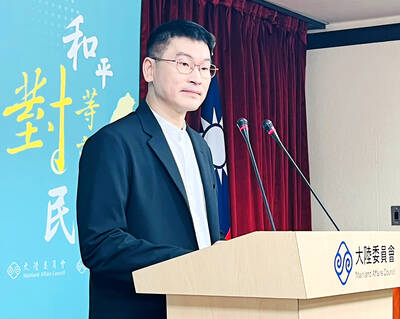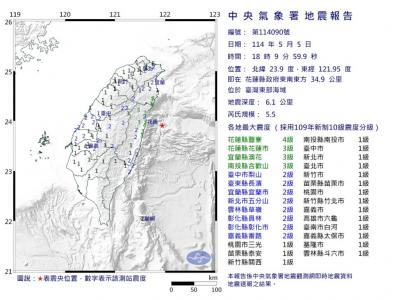The National Theater and Concert Hall (NTCH) has created tactile 3D models of its pipe organ for the visually impaired to experience one of the hall’s defining features.
A set of three models of the famous pipe organ at the National Concert Hall in Taipei were made at 1:30 scale, with some parts hand-carved and others made with 3D laser engraving technology, enabling the visually impaired to learn about the instrument through touch and sound.
The models seek to accurately represent the instrument’s intricate construction in its entirety, including its sophisticated construction and carvings, the NTCH said in a statement.

Photo: CNA
The pipes were made with two different materials, and the set also includes a representation of the keyboard.
They are to feature prominently in the hall’s guided touch tours on April 25 and May 29, which people can register for on the NTCH’s Web site, it said, adding that more sessions would be added.
The pipe organ was handmade by world-renowned organ-building company Flentrop in the Netherlands, tailored to the architecture and scale of the venue, the NTCH said.
The 9m-long, 14m-wide instrument was the largest pipe organ in Asia at the time of its completion, it said.
The NTCH has been striving to integrate the values of sustainability and inclusiveness into its operations in the past few years, NTCH general and artistic director Liu Yi-ru (劉怡汝) said.
Barrier-free access and facilities were incorporated in its Performing Arts Library during a renovation in 2021, while accessibility services such as performances accompanied by contextual subtitles and audio descriptions are offered at the theater and concert hall, she added.
Following the success of touch tours launched at the National Theater in 2017, the NTCH this year organized similar tours at the National Concert Hall to make the venue more accessible to the visually impaired.
The tour, which lasts about an hour, showcases the plaza outside the hall, the lobby, the seating areas and the pipe organ, the NTCH said.
Visitors are invited to familiarize themselves with the plaza and surrounding areas with a tactile guidebook, and are encouraged to “get a feel for” the marble walls and the handrails in the lobby, it said.

An essay competition jointly organized by a local writing society and a publisher affiliated with the Chinese Communist Party (CCP) might have contravened the Act Governing Relations Between the People of the Taiwan Area and the Mainland Area (臺灣地區與大陸地區人民關係條例), the Mainland Affairs Council (MAC) said on Thursday. “In this case, the partner organization is clearly an agency under the CCP’s Fujian Provincial Committee,” MAC Deputy Minister and spokesperson Liang Wen-chieh (梁文傑) said at a news briefing in Taipei. “It also involves bringing Taiwanese students to China with all-expenses-paid arrangements to attend award ceremonies and camps,” Liang said. Those two “characteristics” are typically sufficient

A magnitude 5.9 earthquake that struck about 33km off the coast of Hualien City was the "main shock" in a series of quakes in the area, with aftershocks expected over the next three days, the Central Weather Administration (CWA) said yesterday. Prior to the magnitude 5.9 quake shaking most of Taiwan at 6:53pm yesterday, six other earthquakes stronger than a magnitude of 4, starting with a magnitude 5.5 quake at 6:09pm, occurred in the area. CWA Seismological Center Director Wu Chien-fu (吳健富) confirmed that the quakes were all part of the same series and that the magnitude 5.5 temblor was

The brilliant blue waters, thick foliage and bucolic atmosphere on this seemingly idyllic archipelago deep in the Pacific Ocean belie the key role it now plays in a titanic geopolitical struggle. Palau is again on the front line as China, and the US and its allies prepare their forces in an intensifying contest for control over the Asia-Pacific region. The democratic nation of just 17,000 people hosts US-controlled airstrips and soon-to-be-completed radar installations that the US military describes as “critical” to monitoring vast swathes of water and airspace. It is also a key piece of the second island chain, a string of

The Central Weather Administration has issued a heat alert for southeastern Taiwan, warning of temperatures as high as 36°C today, while alerting some coastal areas of strong winds later in the day. Kaohsiung’s Neimen District (內門) and Pingtung County’s Neipu Township (內埔) are under an orange heat alert, which warns of temperatures as high as 36°C for three consecutive days, the CWA said, citing southwest winds. The heat would also extend to Tainan’s Nansi (楠西) and Yujing (玉井) districts, as well as Pingtung’s Gaoshu (高樹), Yanpu (鹽埔) and Majia (瑪家) townships, it said, forecasting highs of up to 36°C in those areas